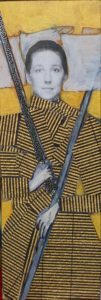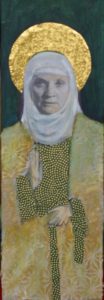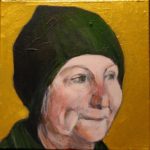Life Moves: Retiring? Not so much - Vancouver Ballet Society
- Home
- Life Moves
- Life Moves: Retiring? Not so much

By Barb Clausen
My career in dance was spent in support of performing artists and in the production of live shows, primarily for three key Vancouver organizations: The Dance Centre, a resource centre for professionals and the public; New Works, which presents and supports local artists; and DanceHouse, which presents mid-size internationally recognized companies. Recently, though, after the significant milestone of retirement, I revisited my own, earlier, artistic practice as a painter.
At the University of California at Berkeley, where I majored in fine arts, I had developed a practice in figurative painting and portraits. But after immigrating to Vancouver, Canada, in 1968, dance captured my attention.

I had studied modern dance in high school in the United States, as a required physical education course, which I chose instead of sports. In Vancouver, I began to study with local modern dance legend Anna Wyman, and later became a mature student in the Extended Studies in Dance program at Simon Fraser University. Fascinated by the art form, but not drawn to the life of a performer, I took my first job in administration with a local collective, Terminal City Dance, which led to a long career in the dance field.

My painting practice continued in fits and starts over the following years. I began to call myself a “lapsed painter,” but presumed I would pick it up in earnest again one day. When I retired and moved to Victoria, a ferry ride away on Vancouver Island, I did. First came five self-portraits, which investigated aspects of my character as well as possibilities for the future. Then came five collages featuring five dance artists of a certain age and status, whom I have known and in some cases worked with over the course of my career. Presenting them as religious icons is slightly tongue in cheek but also indicates my admiration for their persistence and dedication. The project was a sort of love letter and a goodbye to my career in Vancouver.
Then one day when a good friend asked if painting inspired me, I surprised myself by replying, “No.” I realized that I am not drawn to the life of a painter. This is ironic, because now I finally have the time and space and materials to pursue what I always thought I’d be doing post-retirement. I am an extrovert, and days alone in the studio do not satisfy my nature, which is to interact with people.
When that same friend asked what did inspire me, I blurted, “Mentoring.”
My work as a mentor developed gradually over the course of my career. Early on I found myself hiring intelligent and curious people who wanted to work in arts administration, some of them dancers, but others who were intrigued by the field. Because I had founded or co-founded many of the organizations I worked in, and government grants were available to employ untrained staff, I was able to hire people who had many great qualities but no experience in administration. I enjoyed that role. And since these organizations were new, at times even I had to figure out what we were doing. In the earliest days of The Dance Centre, before it was clear what the organization was and would become, I worked with a small staff in a dingy basement office for a year. My first directive to them was, “If anyone calls and asks if we do X, say yes, then come to me and we’ll figure out how to do it together.”
It seemed natural, then, in retirement, to look for volunteer opportunities that included working with people in a mentoring or coaching situation. I found Citizens Counselling, which offers affordable counselling to adult residents of Greater Victoria. Volunteers trained and supervised by the 50-year-old organization itself provide the counselling, on issues ranging from self-esteem, addiction, depression, and grief.
Counselling is not the same as mentoring, of course. Mentors advise or train someone, especially a younger colleague, sharing information about their own career path, as well as providing guidance, motivation, emotional support, and role-modelling. Counselling, as I am learning to do it, is more about providing empathetic and respectful support that will help clients discover and make healthy choices and decisions for themselves.
I am happy to have found a community of like-minded people to train with and to one day work alongside. It feels good to once more be united with others in a common cause — though instead of supporting an art form, we are fostering the mental health of our community.

